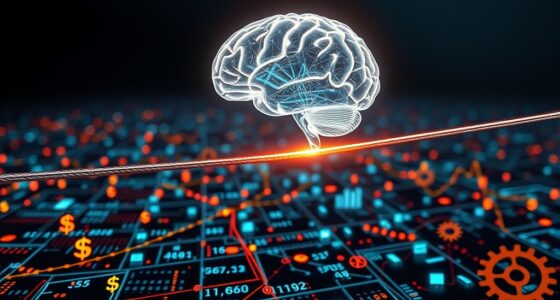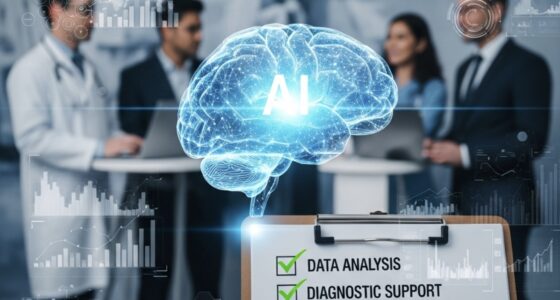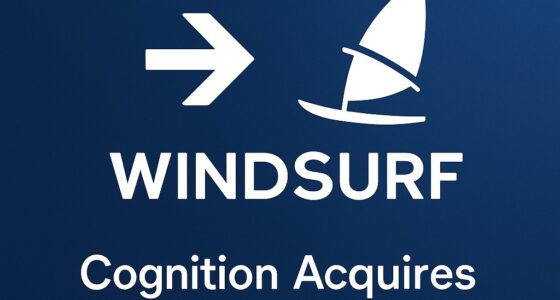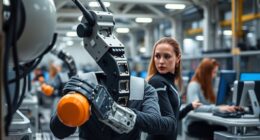AI is transforming the job market by creating new roles, especially in tech, healthcare, and creative fields, but it’s also automating many routine jobs in manufacturing, retail, and transportation. While some roles disappear, new opportunities emerge, and some experts believe AI may generate more jobs in the long run. However, this shift requires you to adapt your skills continuously. To understand how these changes will affect you, keep exploring what’s coming next.
Key Takeaways
- AI is expected to create around 11 million new jobs worldwide, mainly in tech and information sectors.
- Many routine and entry-level roles face high automation risk, leading to job displacement in certain industries.
- Workforce adaptation through reskilling, lifelong learning, and developing creative skills is crucial for capturing new opportunities.
- Overall job market impact depends on economic conditions, with some sectors benefiting and others experiencing stagnation.
- The net effect of AI on employment remains uncertain, balancing job creation in some areas against displacement in others.
The Dual Impact of AI on Employment Across Sectors
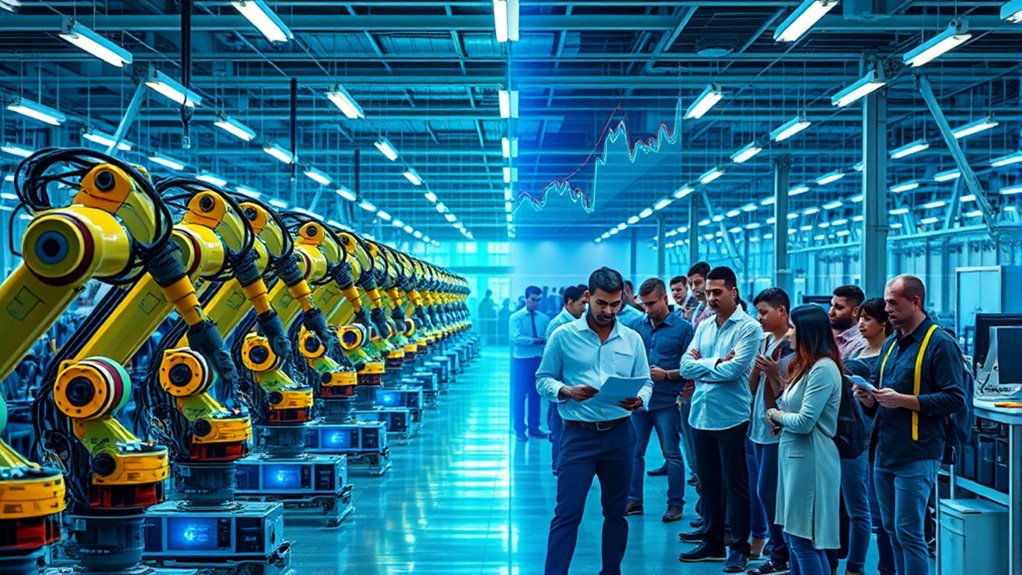
AI is transforming the job landscape in complex ways, creating new opportunities while displacing existing roles across industries. You’ll see AI drive job growth in tech and information sectors, with an estimated 11 million new positions worldwide. However, hiring slows down in retail and hospitality, where growth is modest. Companies are focusing on upskilling their current employees and promoting internal mobility rather than hiring new staff. AI’s expansion into creative and security fields highlights its broadening reach. Despite this growth, economic uncertainty and trade issues slow overall job market progress. While some sectors benefit from AI’s rise, others face stagnation, making the job landscape more volatile. Preparing yourself for these shifts means understanding where AI is creating opportunities and where it’s replacing roles. Additionally, advancements like generative AI and integrated devices such as the Snapdragon 8 Gen 3 are accelerating AI adoption, further influencing employment trends across multiple sectors. As AI integration deepens, it is crucial to consider the impact on workforce training and reskilling to stay competitive in evolving job markets. Moreover, the increasing reliance on AI hardware innovation underscores the pivotal role of specialized hardware in shaping future employment opportunities. Recognizing the importance of technology integration can help professionals adapt more effectively to these ongoing changes.
Which Jobs Are at Risk and Which Are Growing?

As the job market evolves under technological influence, certain roles face higher risks of automation while others continue to grow. Jobs involving repetitive or routine tasks, like data entry, customer service, and bookkeeping, are most vulnerable. Sectors such as manufacturing and transportation could see nearly 50 million jobs impacted, with roles like truck drivers and factory workers at high risk. Entry-level positions are especially at risk, narrowing pathways into the workforce. Conversely, roles that require analytical thinking and complex decision-making, such as financial analysts and AI specialists, are expected to grow. AI-related jobs are projected to create around 11 million new opportunities. Meanwhile, skilled professionals in tech and healthcare will see continued demand, driven by AI’s integration into various sectors. AI is predicted to automate more than 50% of tasks for roles like market research analysts (53%) and sales reps (67%), which underscores the significant transformation underway in the labor market.
The Skills Shift: Preparing for an AI-Driven Workforce
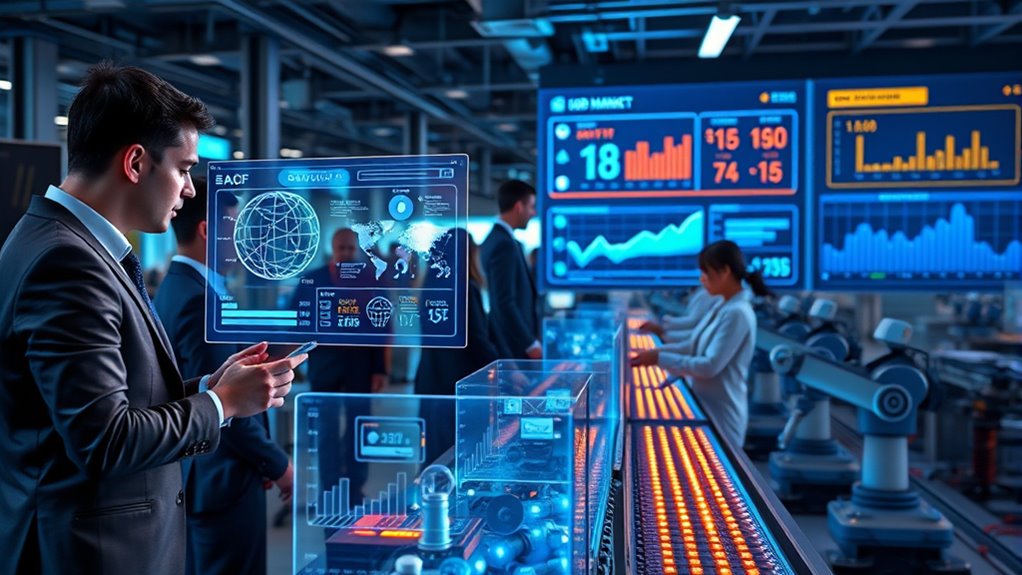
To stay competitive in an AI-driven world, you’ll need to focus on reskilling for future jobs and adapting education strategies. Companies and educators are shifting their approaches to meet the demand for new technical and adaptive skills. Embracing continuous learning now will prepare you for the changing workforce landscape ahead. Rapid workforce transformation is accelerating the need for proactive skill development initiatives to ensure workers remain relevant and resilient in the face of technological change. Recognizing the importance of adaptability skills will be crucial as automation continues to reshape various industries. Additionally, developing breakthrough skills in emerging technologies will be essential for staying ahead in this evolving environment. Emphasizing the cultivation of creative problem-solving abilities can help employees stand out amid automation, especially as technological advancements continue to redefine job roles and industry standards. Building a foundation in home improvement skills, such as organization and decluttering strategies, can also foster a mindset of adaptability and resilience in a rapidly changing job market.
Reskilling for Future Jobs
Preparing for an AI-driven workforce requires you to quickly acquire new skills and adapt to shifting job demands. As AI automates tasks, many roles will change or disappear, making reskilling essential. You’ll need to develop versatile skills like critical thinking, creativity, and technological literacy to stay relevant. Continuous learning becomes indispensable because the pace of change is rapid, and industries such as finance and consulting are already experiencing displacement. Companies are investing in upskilling programs and fostering an innovation mindset, but you’ll also need to embrace flexibility in your career path. Mastering collaboration tools and understanding AI applications can boost your employability. Reskilling isn’t just about individual growth; it’s imperative for maintaining your place in an evolving job market.
Adapting Education Strategies
With AI becoming deeply embedded in education systems, institutions are actively redesigning their strategies to equip learners with future-ready skills. You’ll see a shift toward integrating AI tools that personalize learning and support practical skill development. Vocational training, internships, and apprenticeships are gaining prominence, creating direct pathways to employment. Funding now emphasizes scalable EdTech solutions that focus on workforce training and impact, not just growth. Generative AI-powered tutors and continuous learning platforms help learners adapt quickly to technological changes. Industry partnerships are strengthening, addressing talent gaps through upskilling programs. Education systems are becoming more flexible, adaptable, and responsive, ensuring learners acquire the skills needed for an AI-driven job market. This approach prepares you for a future where practical, industry-aligned skills are essential. Furthermore, governments and private sectors are investing heavily in education funding to support innovative models that bridge skill gaps and foster lifelong learning. Additionally, the integration of predictive modeling in educational data mining allows educators to identify student needs proactively and tailor interventions effectively.
Economic Disruption and Social Mobility Concerns
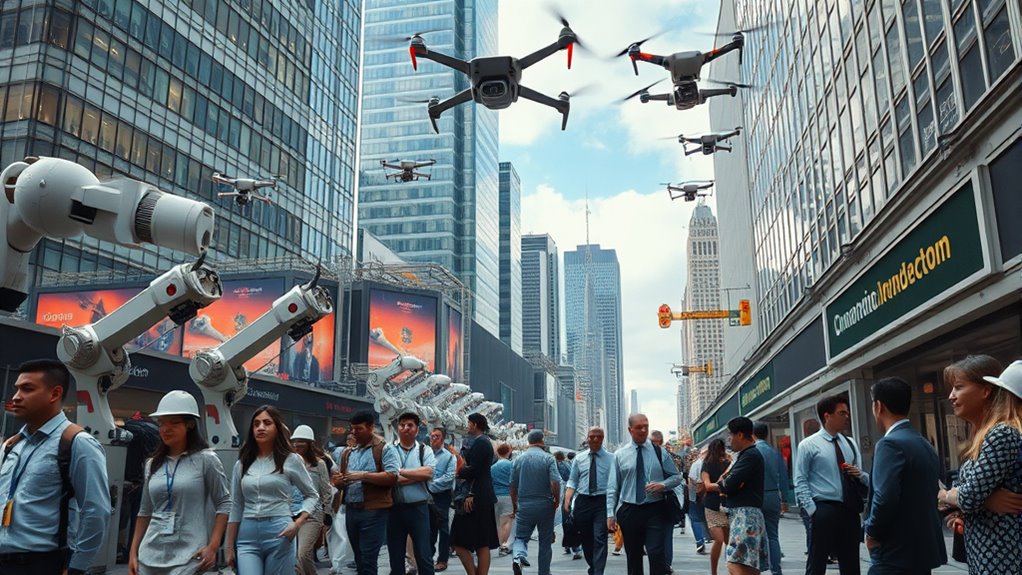
AI’s rapid integration into the economy is causing significant disruption, raising concerns about social mobility. Job displacement varies across industries, with manufacturing hit hardest, while healthcare and education grow. As AI automates tasks, workforces shrink in some sectors, and entry-level roles decline. Meanwhile, AI boosts productivity, potentially widening the wealth gap for those with AI skills. Here’s a quick overview:
| Industry | Impact |
|---|---|
| Manufacturing | Heavy job displacement |
| Healthcare | Growth and new opportunities |
| Education | Increased job prospects |
| Finance | Job automation and shifts |
| Tech | Skill demand and salary rises |
This disruption threatens talent pipelines and social mobility, as companies move operations to regions with cheaper skilled labor, creating a socio-economic divide. Automation’s impact on employment is a crucial factor in understanding the broader economic implications. Additionally, the labor market is becoming more complex as workers need to adapt to rapidly changing skill requirements, which can influence job security and career advancement opportunities.
How Businesses Are Adapting to AI Integration

As businesses face ongoing disruption from AI-driven job shifts, many are actively adopting new strategies to stay competitive. They’re integrating AI across functions, with 36% focusing on IT, while investments soar—92% of executives plan to increase AI spending over three years. The use of generative AI has jumped from 33% in 2023 to 71% in 2024, delivering an impressive ROI of $3.70 per dollar invested. Companies are automating repetitive tasks, enhancing data analysis, and optimizing processes to boost efficiency. They’re also developing training programs to bridge skills gaps and fostering AI literacy among employees. Strategic partnerships and innovation efforts enable early adopters to gain competitive advantages, improve customer experiences, and explore new market opportunities amid evolving challenges. Additionally, integrating Ford Tuning techniques into vehicle upgrades exemplifies how tailored modifications can improve performance and meet specific needs. Moreover, leveraging Natural Language Processing (NLP) capabilities allows businesses to better understand customer sentiment and tailor services accordingly. Recognizing the importance of interior design in creating a welcoming environment can also enhance customer satisfaction and brand loyalty. Furthermore, adopting comprehensive training programs can help mitigate job displacement concerns and prepare the workforce for future roles. Staying informed about juice cleanses and their effects can also be beneficial for employees seeking healthier lifestyle choices in the workplace.
The Future Workforce: Opportunities and Challenges
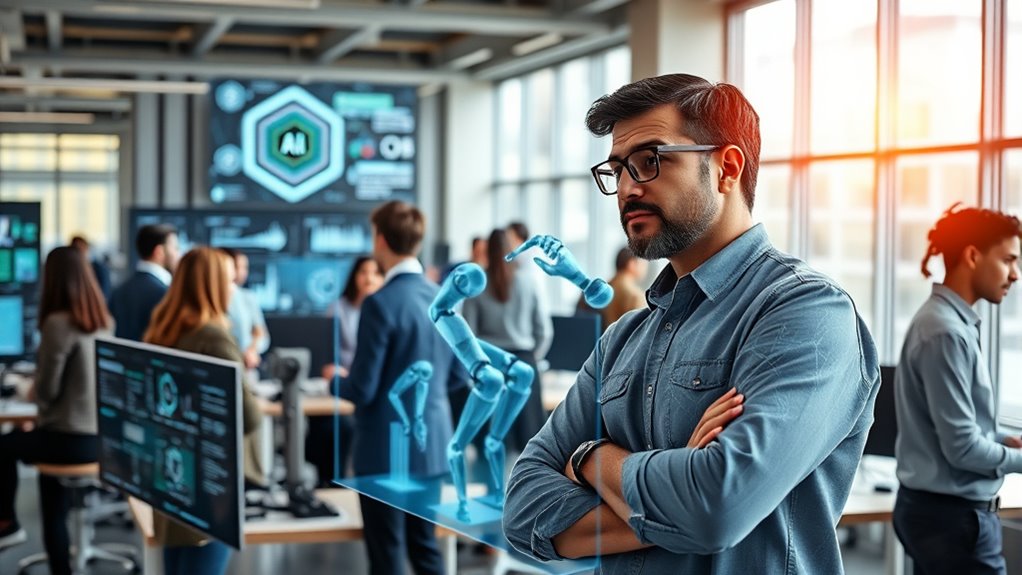
The future of the workforce is shaping up to be both full of opportunities and significant challenges. On one hand, AI could boost global productivity by $4.4 trillion and create millions of new roles, especially in HR and workforce planning. Many companies plan to invest heavily in AI, opening doors to innovation and growth. However, the risk of job displacement looms large, with 300 million jobs potentially lost by 2025 and up to 60% of roles in advanced economies at risk. Workers face uncertainty, with only 6% believing AI will generate long-term opportunities. The table below captures the emotional tug-of-war:
| Opportunities | Challenges |
|---|---|
| New roles in AI and HR fields | Massive job losses and insecurity |
| Increased productivity and growth | Workforce adaptation and retraining |
| More efficient workplaces | Fear and skepticism among workers |
Additionally, the application of the Law of Attraction principles for mindset shifts can play a crucial role in helping individuals navigate these changes with resilience and positivity. Recognizing the importance of technological adaptation is essential for both workers and organizations to thrive amid these shifts.
Strategies for Navigating AI-Related Job Market Changes
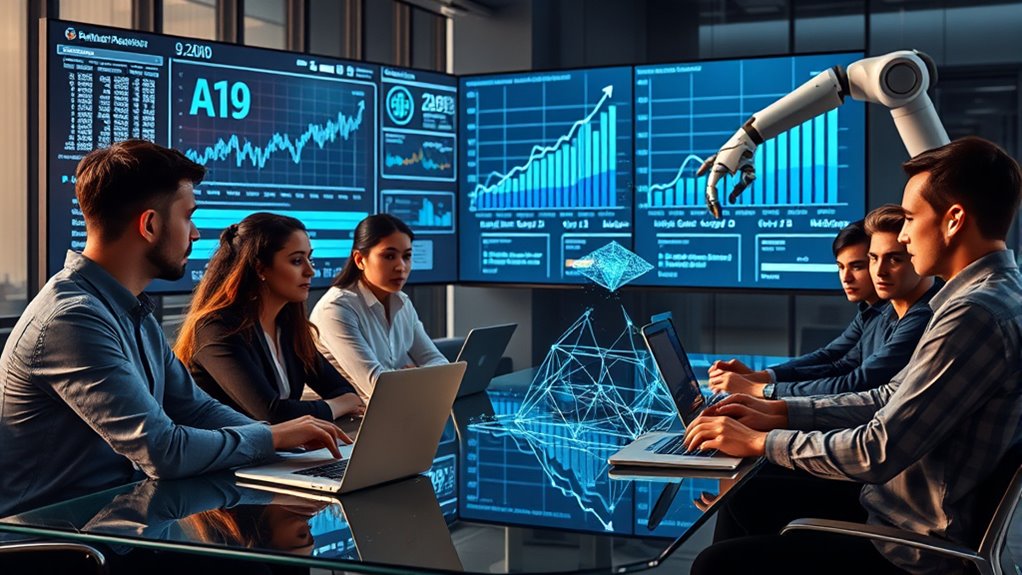
To stay competitive amid AI-driven changes, you need to embrace lifelong learning and continuously update your skills. Developing versatile abilities, like creativity and problem-solving, can make you more adaptable in shifting job markets. Additionally, leveraging AI tools can boost your productivity and help you work alongside new technologies effectively. Understanding the AI bifurcation—the divergence between human and artificial intelligence—can also guide you in identifying areas where human skills remain essential and in adapting strategies accordingly. Engaging in mindful decluttering of your skill set can help you focus on what truly adds value in a rapidly evolving landscape. Recognizing the importance of portable tools like portable camping gear can serve as a reminder to invest in adaptable and versatile assets that enhance resilience across various scenarios. Furthermore, cultivating an understanding of nutritional advantages—such as those found in green juices—can foster adaptability not only in technology but also in personal health and wellness approaches.
Embrace Lifelong Learning
Steering the rapidly evolving AI-driven job market requires embracing lifelong learning as a fundamental strategy. To stay ahead, you need to adapt continuously. Imagine upgrading your skills like sharpening tools in your toolbox, preparing you for new opportunities. Consider these key steps:
- Learn new digital skills to keep pace with AI advancements, like coding or data analysis.
- Focus on human-centered skills such as creativity and problem-solving, which AI can’t replicate.
- Seek out online courses and certifications that align with emerging industries.
- Engage in industry networks to stay informed about market shifts and job trends.
- Developing an understanding of beginners guides can provide foundational knowledge to navigate new technologies effectively.
Develop Versatile Skills
As AI continues to reshape the job landscape, developing versatile skills becomes essential for staying relevant and competitive. You should focus on building transferable skills like problem-solving, creativity, and data literacy, enabling you to adapt across roles. Understanding AI fundamentals allows you to engage meaningfully with new tools, while learning agility helps you quickly acquire emerging technologies. Networking can open doors to opportunities and insights in AI-impacted markets.
| Skill Area | Key Tools/Competencies |
|---|---|
| Technical Proficiency | Python, R, SQL, Hadoop, Spark, RPA tools |
| Soft & Hybrid Skills | Communication, teamwork, emotional intelligence |
| Transferable Skills | Problem-solving, creativity, data interpretation |
| Data Science & Visualization | Tableau, Power BI, statistical analysis |
Leverage AI Tools
Leveraging AI tools effectively can help you adapt to rapid changes in the job market and stay ahead of automation-driven disruptions. By integrating AI into your workflow, you boost productivity and open new opportunities. Here are four ways to leverage AI tools:
- Automate repetitive tasks—freeing up time for strategic work.
- Learn AI-driven analytics—making data-driven decisions confidently.
- Explore AI development and maintenance—creating your own niche in the growing AI industry.
- Collaborate with AI systems—enhancing your skills and boosting efficiency.
Staying proactive with AI tools positions you as an adaptable professional, ready to capitalize on emerging job categories and industry shifts. Embracing AI as a partner rather than a threat can secure your relevance in the evolving job landscape.
Frequently Asked Questions
How Accurate Are AI Job Creation Predictions for Specific Industries?
You might wonder how accurate AI job creation predictions are for specific industries. While projections show substantial growth, they often vary depending on industry adoption rates and regional factors. You should consider that some sectors, like tech, are more likely to see precise forecasts, whereas others might experience unpredictable changes. Staying informed and adaptable helps you navigate these evolving job markets as AI continues to reshape industry landscapes.
What Policies Can Mitigate Ai-Driven Job Displacement?
Imagine AI as a river shaping your career landscape. To prevent floods of job losses, you can support policies like ethical AI deployment, worker retraining, and public-private partnerships. These initiatives act as dams, controlling the flow and ensuring opportunities for all. By promoting inclusive reskilling, transparent governance, and innovation, you help turn potential disruptions into new horizons, guiding workers safely toward a thriving, adaptable workforce.
How Will AI Impact Job Quality and Worker Rights?
You’ll see AI improve job quality by automating routine tasks, freeing you to focus on meaningful work and boosting safety. However, it might also increase your stress and management scrutiny. Worker rights could be at risk from biases and job security concerns, making policies essential. Overall, AI can enhance work conditions and skills, but staying informed and advocating for fair policies guarantees your rights and job quality are protected.
Are Small Businesses Prepared for AI Integration?
You might think small businesses are ready for AI, but many still face challenges. Limited resources, lack of expertise, and concerns about costs slow down adoption. While 77% plan to integrate AI soon, actual implementation varies, especially among very small firms. To succeed, you’ll need affordable, easy-to-use tools and a clear strategy. Staying informed and prepared can help your business leverage AI’s benefits and stay competitive.
How Can Workers Upskill Effectively for Ai-Related Roles?
Think of upskilling as planting seeds in a rapidly changing field. To grow strong in AI roles, you need targeted education through online courses, bootcamps, and hands-on projects. Stay curious and adaptable, absorbing new tools and trends. Leverage employer-supported training programs and industry communities. By continuously nurturing your skills, you’ll cultivate resilience and seize new opportunities in AI, transforming challenges into a fertile ground for career growth.
Conclusion
As you navigate this evolving landscape, envision yourself steering a boat through shifting tides—some currents bring new opportunities, while others require careful steering. Embrace the changing winds as a chance to refine your skills and adapt your sails. Though the horizon may seem uncertain, your resilience and willingness to learn will help you find steady waters. By staying flexible and open-minded, you’ll turn these waves of change into a journey of growth and discovery.



